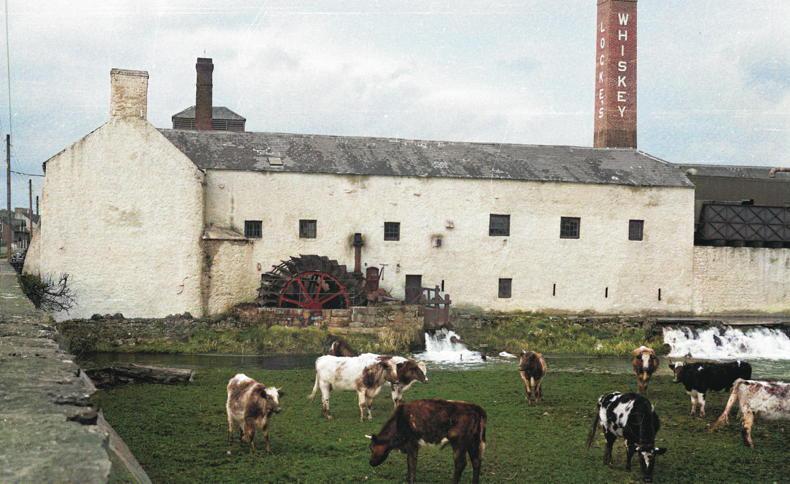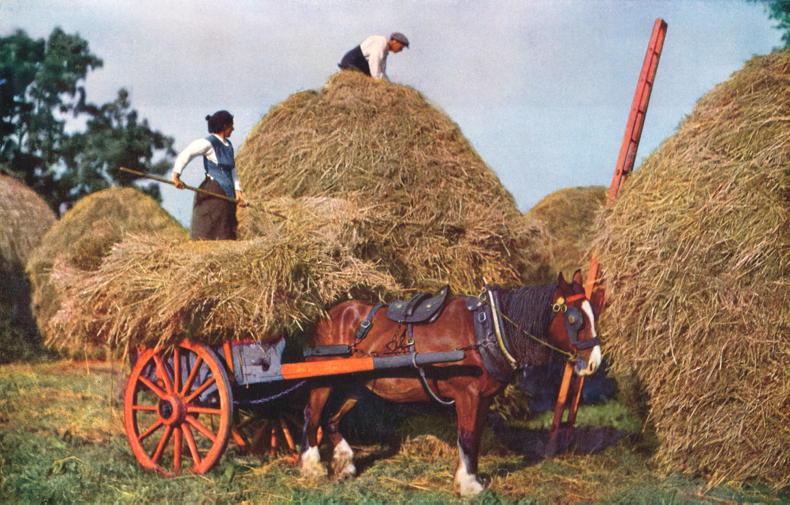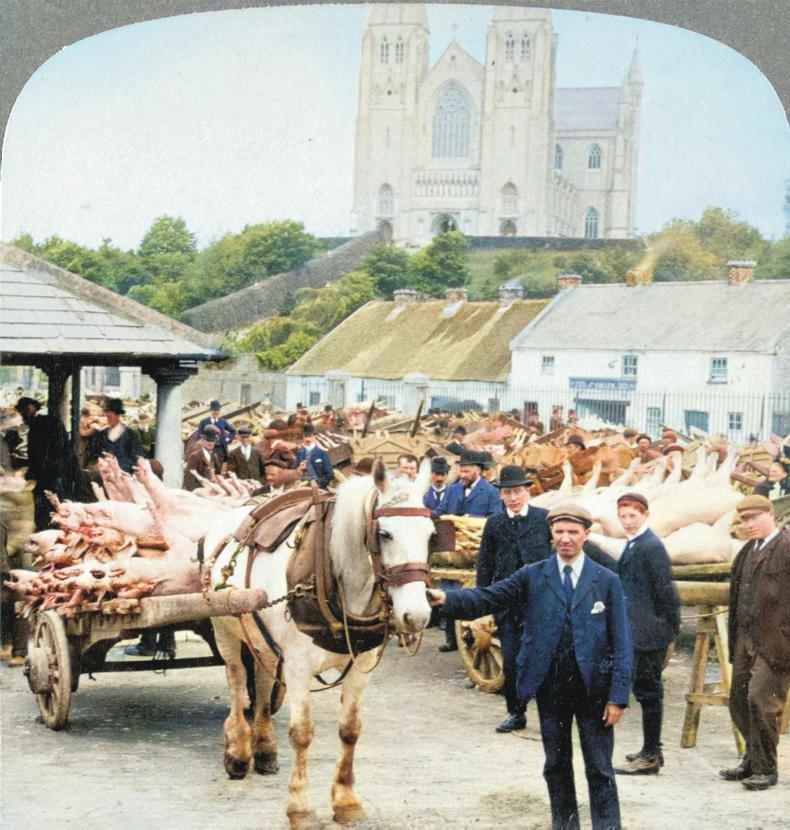In their third instalment of the popular series Old Ireland in Colour, authors professor John Breslin and associate professor Sarah-Anne Buckley (both University of Galway) share insightful snippets of past Irish lives through photography, from politicians of the day to hard-working labourers, farmers, and mischievous children from all corners of the island.
Here, they share a few of these fascinating images with Irish Country Living.

Locke’s Distillery 1937, Kilbeggan, Co. Westmeath.
Locke’s Distillery 1937, Kilbeggan, Co Westmeath
Located in the town of Kilbeggan, on the Brosna river, Kilbeggan Distillery is the oldest licensed distillery in Ireland. It was first opened in 1757, established by Matthew McManus to produce whiskey. The Locke family became involved in 1843. Prior to this, John Locke had married Jane Smithwick from the well-known Kilkenny brewing family and this connection helped the business.
The family ran the distillery until production ceased in 1953. In 1963, the distillery was bought by a German, Karl Heinz Mellor, who sold off the remaining stock of whiskey and turned the building into a pigsty. However, in 1982 the Kilbeggan Preservation and Development Association was formed by the townspeople and acquired a caretaker’s lease. They began fundraising for renovations and the distillery is once again back in the whiskey business.
•Photographer: Unknown, Source: the Breslin Archive.
Harvest 1947, Wilton, Cork (Main picture)
During and after the Second World War, the Irish state implemented a compulsory tillage scheme to get farmers to cultivate wheat and other cereals instead of using the land for dairy or other crops.
Harvesting was an important event for all farmers, particularly when done by hand, as the time pressures and weather conditions were critical. The first Sunday after 15 August was known as ‘Gleaning Sunday’, which marked the annual gathering of the crops. This was followed by ‘picnics, outdoor gatherings and the weaving of harvest knots’ from straw, according to Marion McGarry. It was a family affair, as this photograph shows. The knots would have been worn ‘during the final work and at the festivities that marked the end of the harvest’.
•Photographer: Unknown; Source: Irish Examiner.

A Corner Of Cill Éinne Village c.1893–1895, Inis Mór, Co. Galway.
A Corner Of Cill Éinne Village c.1893–1895, Inis Mór, Co Galway
This first Robert John Welch photograph of Cill Éinne shows a collection of neatly thatched stone-built cottages, some of which are whitewashed. There appears to be part of a high cross in the front garden of the nearest cottage. Cill Éinne boasted one of the earliest monasteries in Ireland, established in the sixth century by St Enda. Enda was a native of Ulster but was granted land on Inis Mór by the king of Munster.
The village of Cill Éinne (which translates to Enda’s church) takes its name from the monastery. The remains of an early eighth-century church known as Teaghlach Éinne (Enda’s household) can still be seen in the graveyard. It is said that Enda and 120 other saints are buried in this graveyard, which is still in use today.
•Photographer: Robert John Welch; Source: Balfour Album, University of Galway Library Archives.

Roscommon Family c.1903, Co Roscommon.
Roscommon Family c.1903, Co Roscommon
Family portraits were a common feature of the late nineteenth century. This image, labelled by the photographer from Underwood and Underwood as ‘Sturdy Folk of Old Ireland’, captures a couple and their six children.
We do not know who the family are, but their clothing is good quality and the fashion is of the time – the sailor outfit, pinafores and the father’s woollen suit. They are wearing boots that are slightly worn but well cared for. The expressions on all are serious; the taking of their photograph was most probably not a regular occurrence for this family.
•Photographer: Underwood & Underwood; Source: Library of Congress.

“Hay Is Erin’s Chief Crop” 1926.
“Hay Is Erin’s Chief Crop” 1926
In 1926, over half of Ireland’s population worked in agriculture, and this dependence on one industry, at a time of decreasing demand, would see the migration of almost 150,000 workers over the coming years.
•Photographer: Clifton Royal Adams; Source: the Breslin Archive. Original in colour and has been enhanced, not colourised.

Two Farming Gentlemen 1937.
Two Farming Gentlemen 1937, Connemara
This image was taken a year prior to the end of the ‘Economic War’. In 1926, land annuities (money loaned by the British government to Irish farmers before 1921, which the farmers had agreed to repay) had begun to receive attention as substantial arrears had built up.
The Cumann na nGaedheal government officially agreed to continue to pay, but figures such as Peadar O’Donnell began an anti-annuities campaign and in 1932 the new Fianna Fáil government withheld the general payment due in July. The British responded swiftly with a tax on Irish imports designed to recoup their loss, which in turn provoked Irish tariffs on British imports. This sparked the Economic War, which would end in early 1938 when de Valera agreed a one-off payment of £10 million. It was a victory, aside from the effects the trade war had had on farmers – particularly large cattle farmers.ers – particularly large cattle farmers.
•Photographer: Unknown; Source: the Breslin Archive.

Dressed Pork c.1900–1910, Armagh.
Dressed Pork c.1900–1910, Armagh
The market place in Armagh, where the pigs are dressed and ready to be removed. This area has had market rights since the 15th century and a corn market was established in 1827 selling grain, grass, seed, pork and corn. This evolved into a cattle market that operated until the 1970s. Today the area hosts the Shambles Variety Market. In the background can be seen the shopfront of the Cullens of nearby Edward Street, who were blacksmiths and animal dealers.
The Roman Catholic St Patrick’s Cathedral dominates the background. Built on an elevated site known as Tealach na Licci (Sandy Hill), where legend has it Saint Patrick brought a young deer for sanctuary, it was started in 1840. Building had to be suspended during the Great Famine, but it was dedicated for worship in 1873. However, the interior decoration was not completed until the early twentieth century, so the building was finally consecrated in 1904.
•Photographer: Underwood & Underwood; Source: Library of Congress.

Three Generations of Connemara c.1926, Co Galway.
Three Generations of Connemara c.1926, Co Galway
This shows a traditional cottage with a thatched roof held down by a net of grass ropes called súgáin, weighted at the ends with rocks.
•Photographer: Clifton Royal
Adams; Source: the Breslin Archive.

Paisley Shawl October 1863, Shinrone, Co. Offaly.
Paisley Shawl October 1863, Shinrone, Co Offaly
This is an image of Miss Jinney/Jane Burton. She died in 1865 aged 83; she was 81 when this photograph was taken.
Her brother, Robert ‘Bob’ Burton, died in 1875 aged 86. Both lived longer than the average life expectancy.
•Photographer: William Cripps Ledger; Source: the Breslin Archive.
The third edition of Old Ireland in Colour can be purchased in most bookstores or online at irishacademicpress.ie (€19.99).
Scan the code to be in with a chance to win a book
Irish Country Living are pleased to give away a copy of Old Ireland in Colour to five lucky readers. Simply scan the QR code with your mobile phone and answer the question: Which edition of Old Ireland in Colour was published in 2023?
A: First B: Second C: Third.

WIN A BOOK
Read more
The Kerry Cowboy: ‘I answer questions from all over the world'
Author Cecily Gilligan: ‘I love the stories of Ireland long ago'
In their third instalment of the popular series Old Ireland in Colour, authors professor John Breslin and associate professor Sarah-Anne Buckley (both University of Galway) share insightful snippets of past Irish lives through photography, from politicians of the day to hard-working labourers, farmers, and mischievous children from all corners of the island.
Here, they share a few of these fascinating images with Irish Country Living.

Locke’s Distillery 1937, Kilbeggan, Co. Westmeath.
Locke’s Distillery 1937, Kilbeggan, Co Westmeath
Located in the town of Kilbeggan, on the Brosna river, Kilbeggan Distillery is the oldest licensed distillery in Ireland. It was first opened in 1757, established by Matthew McManus to produce whiskey. The Locke family became involved in 1843. Prior to this, John Locke had married Jane Smithwick from the well-known Kilkenny brewing family and this connection helped the business.
The family ran the distillery until production ceased in 1953. In 1963, the distillery was bought by a German, Karl Heinz Mellor, who sold off the remaining stock of whiskey and turned the building into a pigsty. However, in 1982 the Kilbeggan Preservation and Development Association was formed by the townspeople and acquired a caretaker’s lease. They began fundraising for renovations and the distillery is once again back in the whiskey business.
•Photographer: Unknown, Source: the Breslin Archive.
Harvest 1947, Wilton, Cork (Main picture)
During and after the Second World War, the Irish state implemented a compulsory tillage scheme to get farmers to cultivate wheat and other cereals instead of using the land for dairy or other crops.
Harvesting was an important event for all farmers, particularly when done by hand, as the time pressures and weather conditions were critical. The first Sunday after 15 August was known as ‘Gleaning Sunday’, which marked the annual gathering of the crops. This was followed by ‘picnics, outdoor gatherings and the weaving of harvest knots’ from straw, according to Marion McGarry. It was a family affair, as this photograph shows. The knots would have been worn ‘during the final work and at the festivities that marked the end of the harvest’.
•Photographer: Unknown; Source: Irish Examiner.

A Corner Of Cill Éinne Village c.1893–1895, Inis Mór, Co. Galway.
A Corner Of Cill Éinne Village c.1893–1895, Inis Mór, Co Galway
This first Robert John Welch photograph of Cill Éinne shows a collection of neatly thatched stone-built cottages, some of which are whitewashed. There appears to be part of a high cross in the front garden of the nearest cottage. Cill Éinne boasted one of the earliest monasteries in Ireland, established in the sixth century by St Enda. Enda was a native of Ulster but was granted land on Inis Mór by the king of Munster.
The village of Cill Éinne (which translates to Enda’s church) takes its name from the monastery. The remains of an early eighth-century church known as Teaghlach Éinne (Enda’s household) can still be seen in the graveyard. It is said that Enda and 120 other saints are buried in this graveyard, which is still in use today.
•Photographer: Robert John Welch; Source: Balfour Album, University of Galway Library Archives.

Roscommon Family c.1903, Co Roscommon.
Roscommon Family c.1903, Co Roscommon
Family portraits were a common feature of the late nineteenth century. This image, labelled by the photographer from Underwood and Underwood as ‘Sturdy Folk of Old Ireland’, captures a couple and their six children.
We do not know who the family are, but their clothing is good quality and the fashion is of the time – the sailor outfit, pinafores and the father’s woollen suit. They are wearing boots that are slightly worn but well cared for. The expressions on all are serious; the taking of their photograph was most probably not a regular occurrence for this family.
•Photographer: Underwood & Underwood; Source: Library of Congress.

“Hay Is Erin’s Chief Crop” 1926.
“Hay Is Erin’s Chief Crop” 1926
In 1926, over half of Ireland’s population worked in agriculture, and this dependence on one industry, at a time of decreasing demand, would see the migration of almost 150,000 workers over the coming years.
•Photographer: Clifton Royal Adams; Source: the Breslin Archive. Original in colour and has been enhanced, not colourised.

Two Farming Gentlemen 1937.
Two Farming Gentlemen 1937, Connemara
This image was taken a year prior to the end of the ‘Economic War’. In 1926, land annuities (money loaned by the British government to Irish farmers before 1921, which the farmers had agreed to repay) had begun to receive attention as substantial arrears had built up.
The Cumann na nGaedheal government officially agreed to continue to pay, but figures such as Peadar O’Donnell began an anti-annuities campaign and in 1932 the new Fianna Fáil government withheld the general payment due in July. The British responded swiftly with a tax on Irish imports designed to recoup their loss, which in turn provoked Irish tariffs on British imports. This sparked the Economic War, which would end in early 1938 when de Valera agreed a one-off payment of £10 million. It was a victory, aside from the effects the trade war had had on farmers – particularly large cattle farmers.ers – particularly large cattle farmers.
•Photographer: Unknown; Source: the Breslin Archive.

Dressed Pork c.1900–1910, Armagh.
Dressed Pork c.1900–1910, Armagh
The market place in Armagh, where the pigs are dressed and ready to be removed. This area has had market rights since the 15th century and a corn market was established in 1827 selling grain, grass, seed, pork and corn. This evolved into a cattle market that operated until the 1970s. Today the area hosts the Shambles Variety Market. In the background can be seen the shopfront of the Cullens of nearby Edward Street, who were blacksmiths and animal dealers.
The Roman Catholic St Patrick’s Cathedral dominates the background. Built on an elevated site known as Tealach na Licci (Sandy Hill), where legend has it Saint Patrick brought a young deer for sanctuary, it was started in 1840. Building had to be suspended during the Great Famine, but it was dedicated for worship in 1873. However, the interior decoration was not completed until the early twentieth century, so the building was finally consecrated in 1904.
•Photographer: Underwood & Underwood; Source: Library of Congress.

Three Generations of Connemara c.1926, Co Galway.
Three Generations of Connemara c.1926, Co Galway
This shows a traditional cottage with a thatched roof held down by a net of grass ropes called súgáin, weighted at the ends with rocks.
•Photographer: Clifton Royal
Adams; Source: the Breslin Archive.

Paisley Shawl October 1863, Shinrone, Co. Offaly.
Paisley Shawl October 1863, Shinrone, Co Offaly
This is an image of Miss Jinney/Jane Burton. She died in 1865 aged 83; she was 81 when this photograph was taken.
Her brother, Robert ‘Bob’ Burton, died in 1875 aged 86. Both lived longer than the average life expectancy.
•Photographer: William Cripps Ledger; Source: the Breslin Archive.
The third edition of Old Ireland in Colour can be purchased in most bookstores or online at irishacademicpress.ie (€19.99).
Scan the code to be in with a chance to win a book
Irish Country Living are pleased to give away a copy of Old Ireland in Colour to five lucky readers. Simply scan the QR code with your mobile phone and answer the question: Which edition of Old Ireland in Colour was published in 2023?
A: First B: Second C: Third.

WIN A BOOK
Read more
The Kerry Cowboy: ‘I answer questions from all over the world'
Author Cecily Gilligan: ‘I love the stories of Ireland long ago'















 This is a subscriber-only article
This is a subscriber-only article










SHARING OPTIONS: